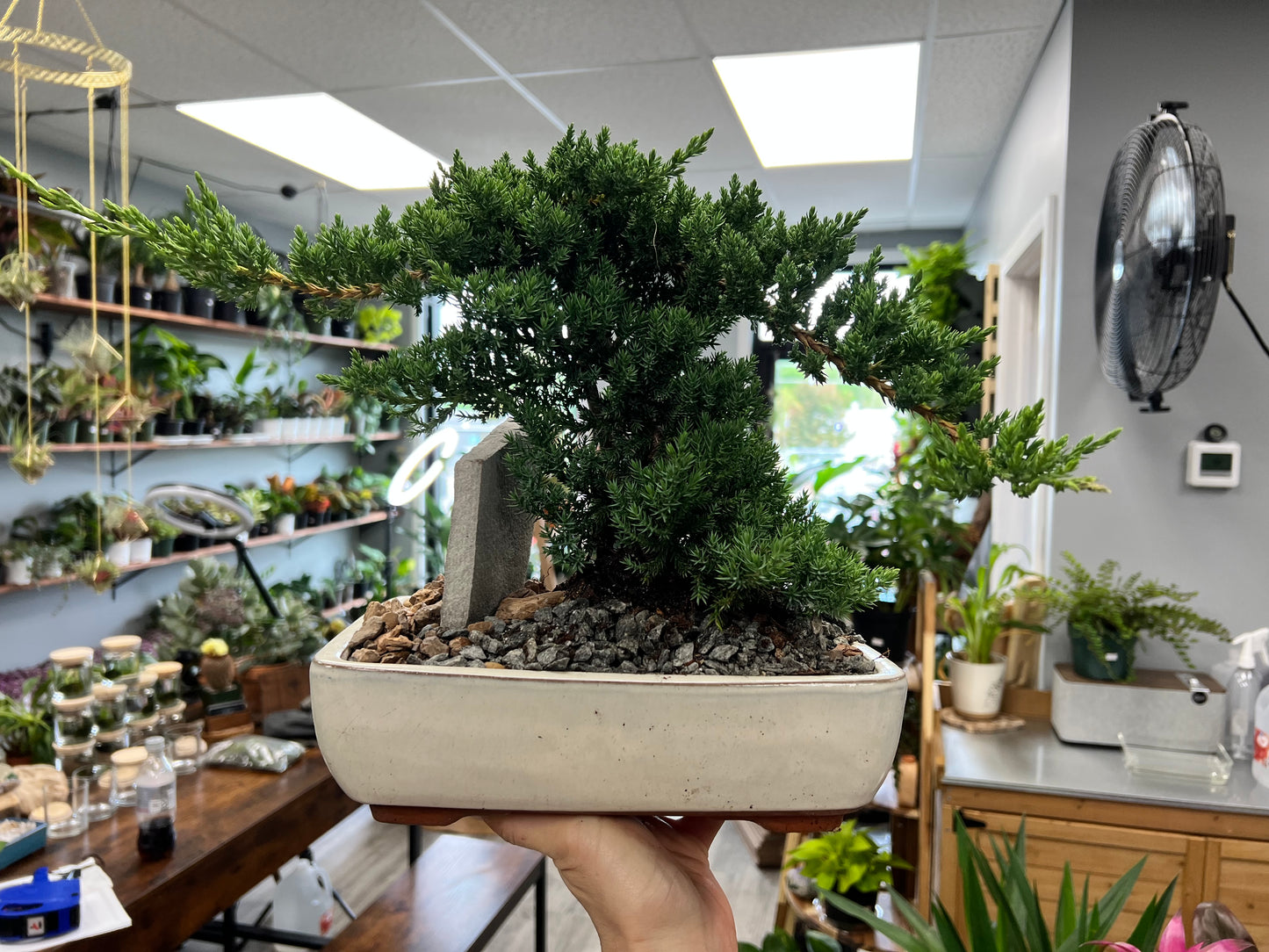The Rooted Plant Shop
Bonsai tree 10”
Bonsai tree 10”
Couldn't load pickup availability
Juniper bonsai requires attention to its watering, light, pruning, and overall environment. Here’s a guide to help you take care of it:
1. Light
- Location: Juniper bonsai trees need a lot of sunlight, ideally 4-6 hours of direct sunlight each day. They are best kept outdoors, as they thrive in natural conditions.
- Indoors: If kept indoors, place it in a sunny window with plenty of natural light. A grow light can be used to supplement if necessary.
2. Watering
- Soil Moisture: Water your juniper bonsai when the top of the soil feels dry to the touch, but don’t let it dry out completely. Ensure the pot has good drainage to prevent root rot.
- Watering Technique: Water thoroughly, allowing the water to drain out of the bottom of the pot. Avoid leaving water sitting in the saucer.
3. Temperature and Humidity
- Junipers prefer cooler temperatures, generally between 55-75°F (13-24°C). They are not suited for extreme heat or frost, so protect them during very hot or cold spells.
- They do best in moderate humidity. If indoors, you might want to increase humidity by using a humidity tray or misting occasionally.
4. Pruning and Shaping
- Pruning: Regular pruning is essential to maintaining the shape and health of your juniper bonsai. Trim any long shoots or branches, particularly those growing inwards or crossing other branches.
- Wiring: Junipers are flexible enough for wiring to shape their branches, but avoid excessive bending, as this can damage the tree.
- Deadwood: Junipers often develop attractive deadwood features (called "jin" and "shari"), which can be shaped over time. However, avoid excessive deadwood removal, as it can stress the tree.
5. Fertilizing
- Frequency: Fertilize during the growing season (spring to early autumn) every 4-6 weeks with a balanced liquid fertilizer or slow-release granules.
- Dormancy: In winter, when the tree is dormant, reduce or stop fertilizing.
6. Repotting
- When to Repot: Juniper bonsai should be repotted every 2-3 years. This helps refresh the soil and trim back any overgrown roots. Repot in early spring, just before the growing season starts.
- Root Pruning: Trim the roots carefully when repotting, removing any dead or excessively long roots. Be sure to use a well-draining bonsai soil mix.
7. Pest and Disease Management
- Junipers are relatively pest-resistant but can occasionally attract aphids, scale insects, or spider mites. Inspect the tree regularly and treat any infestations promptly with insecticidal soap or neem oil.
- Keep an eye out for fungal infections, especially in humid conditions. Proper watering and good airflow can help prevent this.
Share


Let customers speak for us
from 424 reviewsThe packaging was great. Everything safe and secure. Beautiful fully intact plant with a cozy heat pack.

This is my 2nd time purchasing an Alocasia Polly 4 1st time in the winter 😍 40 hour heat pack was surprisingly hot on arrival Superbly Packaged! Super healthy and pretty I’m so happy thank you

Loving it so far! It’s beautiful!

Do not hesitate! Add to cart and checkout, you won’t be disappointed. Mel is incredibly knowledgeable and has taught me so much, she doesn’t just sell plants she teaches and shows you how to keep them alive and thriving! I always receive my plants quickly, and most important - safely. Mel packages them with so much care, and ensures they will make the voyage okay! We are in the thick of winter in Wisconsin, and both times our heat pack was still warm and plants were good. And I haven’t even mentioned the quality, huge selection and amazing prices! One other thing worth noting is none of her plants will come with problematic pests like many bug box, ope I mean big box stores! Here are a few photos, I wish I could share more than 5.
This plant arrived healthy and beautiful in spite of below freezing tempertures outside. 😁

All of my plants arrived perfect and are so beautiful! Will be coming back.

Packaging was great!!! Plants arrived is great condition and heat pack was still a little warm.

She was delivered looking like perfection! She was packed beautifully. Mel is my new go-to for all my plants!

Plant arrived quickly and heathy Inspite of cold temps. Plant was wrapped and shipped with the utmost protection and care!!! The firefly is doing well in her new home!!!! Will purchase again from The Rooted Plant shop without hesitation!!








